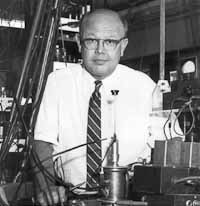


Nuclear Reactions
Nuclei at the center of atoms are very small. If you imagine a nucleus to be the size of a flea, the atom would be the size of a football field. If you then imagine an atom to be the size of a flea, you would be taller than the distance to the moon. Nuclei really are very tiny.Hydrogen is the simplest atom with a single negatively-charged electron orbiting a single positive proton. Three fourths of the universe is hydrogen. Only at high velocities can protons overcome their mututal electrical repulsion to get close enough for the very strong, but very short-range nuclear force to pull them together.
The 1930's were halcyon years for nuclear physics. The neutron, positron and cosmic radiation were discovered. Elements were synthesized using newly invented nuclear accelerators. Nuclear properties were being measured and nuclear theory became real physics. An understanding of the enormous energies that can be released led to thoughts of bombs and to solving the puzzle of how stars radiate so much energy.
In 1939 Hans Bethe reasoned that an "important source of energy in ordinary stars is the reactions of carbon and nitrogen with protons" where the carbon and nitrogen merely serve as catalysts for the combination of four protons (and two electrons) into an alpha particle which is two protons and two neutrons bound together. Helium is an atom with an alpha nucleus with two electrons. But protons can also react directly with each other and electrons to create alpha particles.
Astrophysics came of age as physicists merged laboratory measurements of nuclear reactions with astronomical observations to decipher the riddles they pose. Classic interactions of nuclear theorists, nuclear experimentalists, and astronomers soon led to the hypothesis that perhaps all elements detected in the Universe result from protons in the nuclear furnaces of stars.
William Fowler played a prominent role in studying the nuclear reactions involved in creating elements in stellar environments, working closely with astrophysicists Geof and Margaret Burbidge and Fred Hoyle. In 1957 the four of them published their seminal paper, widely known as "B2FH."
Bethe was to receive a Nobel Prize for "his discoveries concerning the energy production in stars" and Fowler for "his theoretical and experimental studies of the nuclear reactions of importance in the formation of the chemical elements in the universe."
Geof Burbidge